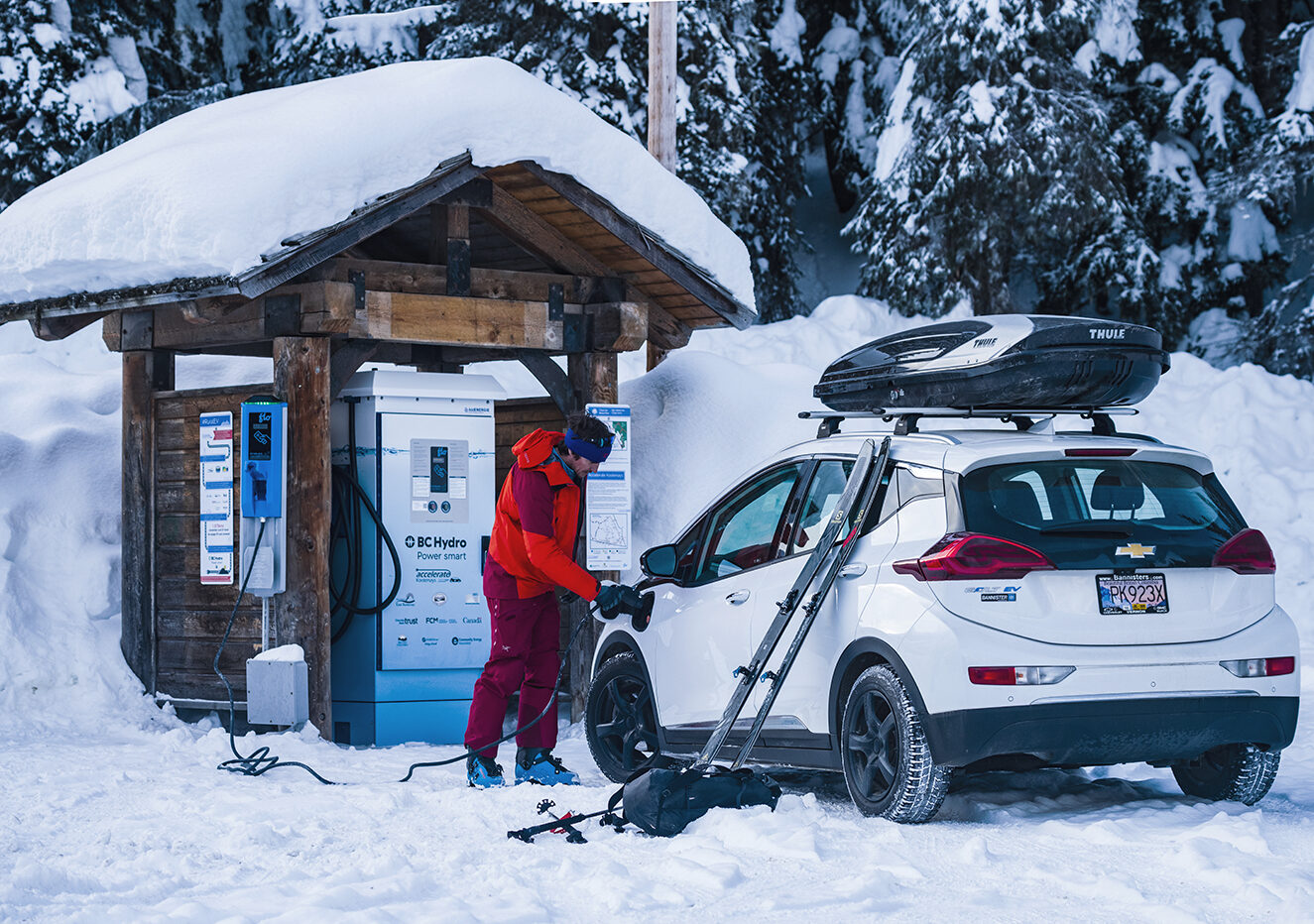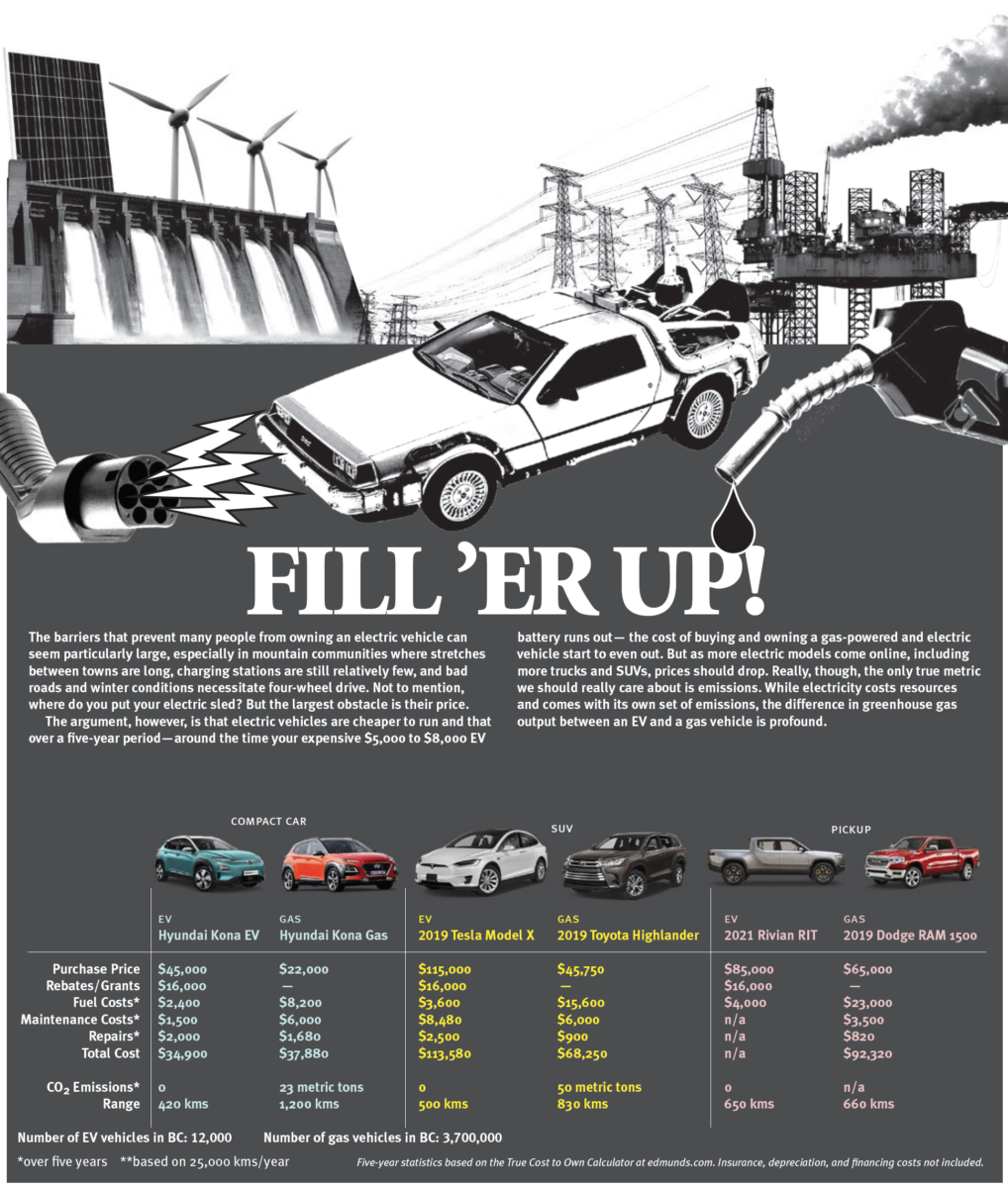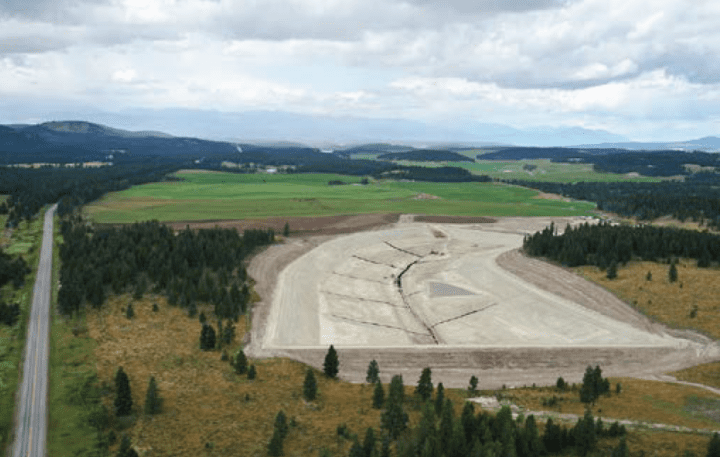The future ain’t all doom and gloom if we consider footprint-sensitive initiatives. Saving wasted food, using waste water, switching to electric cars, and building solar powered, low-impact homes: we explore classy ideas making headway in the Kootenays.
This story was published in KMC #36 – The Future Issue – Winter 2019/20
While much of the world seems be stuck in an endless spin cycle of climate doom and gloom, many Kootenay initiatives are getting on with the good work of embracing sustainability by moving away from petroleum, generating renewable power, and thinking hard about good food and fresh water and how not to waste it.
Change scares us. But how do we counter the typical head-lines that accompany big lifestyle shifts? “What about all those jobs we’ll lose?” “What will happen to our communities?” “What about our children’s future?” Investors in oil and plastic have a strong motivation to drop anchor and keep us in the same oil-slicked harbour for as long as possible. But the proverbial tipping point is here, and a lot of change is happening at the local level, as the bulk of our personal greenhouse gas emissions come from feeding our families, heating our homes, and getting ourselves from point A to point B. Passionate Kootenay thinkers and doers are leaders in reducing what we need to thrive. Helping to define the new economy not only adds to the stoke of living here, it gives us a chance to prosper financially.

Transportation: No Emissions Anyone?
Despite the optics from any local parking lot, with its army of extra-large petroleum-powered pickups and SUVs, a mass Kootenay conversion to electric vehicles (EVs) is not as far off as you might think. Initially limited by lower battery ranges, two-wheel drive, or hybrid-only options, EVs that can accommodate Kootenay living are finally here. New models by Hyundai, Kia, and Chevrolet perform well on hilly highways and boast a range of around 400 kilometres (250 miles) per charge, a critical breakthrough in a region where the next town could be over 100 kilometres (62 miles) away.
Grants can bring the cost of a new long-range EV down to under $30,000, with $6,000 available through the BC Scrap-It Program, a $5,000 federal EV grant, a $5,000 provincial EV grant, plus an $1,100 BC Hydro grant to install a home charging station. And these vehicles are significantly easier to main-tain. The standard internal combustion drivetrain has roughly 1,500 moving parts most of us cannot name, let alone fix. Electric motors have 20–50 moving parts, and although most of us still cannot name or fix them, the lower maintenance costs are good. With your new EV you can kiss goodbye to brakes (braking is accomplished through regenerative charging of the battery, except in rare emergency situations where normal brakes would still be needed), oil changes, exhaust, and trans-mission, which is non-existent in EV direct-drive motors.
Drivers cruising 20,000 to 25,000 kilometres (12,430 to 15,530 miles) per year will spend roughly $1,500 to $6,000 on fuel, depending on driving habits, fuel type, and vehicle efficiency. Over 10 years the math is simple: you will save $15,000 to $60,000, plus hundreds of trips to the gas stations you once frequented. Norway, where nearly 50 per cent of new vehicle sales in 2018 were electric or hybrid, has already done the math. In British Columbia, EVs account for six per cent of new vehicle sales in 2019, meaning the province is well on its way to its mandated target of zero-emissions vehicles making up 10 per cent of new vehicles sold by 2025, and 100 per cent by 2040.
Food: Grow It, Don’t Throw It
Second Harvest is Canada’s largest food-recovery organization, rescuing enough “waste” food to create 34,000 meals daily. It has diverted over 63 million kilograms of food from landfills since it was founded in 1985. The organization’s 2016 techni-cal report, The Avoidable Crisis of Food Waste, found that over 50 per cent, or 35.5 million metric tonnes, of Canadian food was thrown out somewhere between the farm and the table. The value of this food, $49.5 billion, was nearly 52 per cent of what Canadians spent on that food in the first place. Not wast-ing food suddenly seems like a really great idea once you factor in the fuel and water required to produce, process, and ship the food to consumers, then add more fuel to move it from the home to the transfer station to the landfill, where it requires more fuel to be buried and where it will slowly decompose, eventually releasing roughly 56.5 million tonnes of carbon dioxide equivalent in methane.
Enter Healthy Kimberley’s Food Recovery Project, which has a goal of simply reducing food waste by recovering food from retail outlets that is nearing or past its best-before date. “Since we started in November 2018, we have saved nearly 1,050 kilo-grams per month of food from being thrown away,” explains coordinator Kandice Mueller. “We get food donated from local stores and sort and weigh it into four categories: produce, dairy, protein, and grains. Produce and dairy account for 85 per cent by weight of the food we recover.”
The recovered food is then distributed to local schools, food banks, and volunteers. “We had so much food that we decided to open up to the public once per week, which was not a part of our original model,” says Mueller. “But it has been really well received.” The program is on track to divert over 12,000 kilograms of food on its way to local landfills. “Anything unfit for human consumption we compost locally,” explains Mueller. “Compost is better than landfill, but not as good as feeding people.”

Power to the People: Wind
Our need for power is unlikely to disappear any time soon, but we can significantly reduce our consumption if we source power locally and sustainably, rather than relying on import-ing it from Alberta coal plants like much of the East Kootenay. There is great potential for both wind and solar power generation in and around the Kootenays.
In 1993, the Alberta skyline just east of the Kootenays was transformed with the installation of TransAlta’s Cowley Ridge wind farm between Lundbreck and Pincher Creek. The first large-scale wind generation project in Canada, it was retired in 1996 after over 20 years of power generation. However, it served as a critical forerunner for a suite of wind-power projects around Pincher Creek that are designed to take advantage of the consistently powerful Chinook winds that sweep down from the Continental Divide, compressing and building as they create what’s often referred to as the “wind capital of Canada.” Today, over 270 giant turbines zipper the flatland skies; another 150 are in planning stages, which, if built, would bring total power generation to nearly 900 megawatts. A two-megawatt wind generator can feed over 500 average homes in the province, making our neighbour’s Chinook winds a potential power plant for nearly 250,000 houses.
Here in British Columbia, wind power accounts for just three per cent of overall power generation, and while many ridgetop areas around windy Cranbrook and the nearby Wycliffe area, also known as “Windcliffe,” have been surveyed and proposed as potential wind-power sites, most of the current capacity is located in the north of the province, around Tumbler Ridge. The future of British Columbia’s wind energy and sustainable energy in general is currently in limbo, as the construction of the highly controversial Site C Dam on the Peace River combined with the closure of many local pulp, paper, and lumber mills, which guzzle large amounts of power, is expected to leave the province in an energy surplus situation for decades to come.

Power to the People: Nelson Shares the Sun
With a well-established car-share co-op and successful land co-ops showing the benefits of shared resources, a town like Nelson is a natural fit for the Solar Garden, a community solar program. The idea is that locals can purchase solar cells to be installed in a sunny location and share the benefits.
Carmen Proctor, program coordinator of Nelson Hydro’s EcoSave program, is the project manager of the Solar Garden, which currently boasts 248 solar modules. “It was connected to the grid June 2017 and has produced nearly 70,000 kilowatt hours per year, which is what we were hoping,” she explains. “There are just over 140 investors, most having one panel but some up to 15. The best thing is that we did this project as a ‘first,’ so we kept things small in scale in hopes that it could be replicated by other communities. Within the first year it was successfully replicated by the City of New Westminster, who are working on a Phase 2 due to demand and success.”
Energy from the Solar Garden enters the grid and investors receive a credit for energy generated based on current rates. The current kickback is approximately a $30 credit per year per solar panel, an amount that will rise as electricity rates climb in the future.
Water: One Town’s Sewage
Recovering waste products and repurposing them is a critical facet of a sustainable future. Cranbook has been leading the way since the 1970s with its sewage treatment program. With recent upgrades to water storage and treatment facilities, efficient sprinkler heads, and high-tech computer-controlled irrigation platforms, Cranbrook’s waste-water system is cutting edge and truly unique. Instead of returning waste water to the nearest creek or lake like most municipalities, Cranbrook takes advantage of its wide-open Rocky Mountain Trench geography and stores treated waste water, which it then uses to irrigate over 800 hectares of city-owned land purposed to grow cattle feed. It is the essence of sustainability: turning a waste product into a resource to be captured and reused.
“The city has partnerships with five ranching families,” says Tony Pighin, site manager of Spray Irrigation Fields. “The farmers take care of prepping the ground, seeding, and harvest, and we take care of the irrigation. Most people think we are using the waste water as fertilizer, but really it is just water. It has been treated and left for extra treatment in our large, aerated storage lagoons, then it is treated with UV light to sterilize it before it is applied to the crop. It is just water.” Cranbrook’s waste water helps grow over 2,000 head of cattle every year, plus due to the fees paid by the ranchers for cattle feed, the city’s residents enjoy the lowest household rates for waste-water treatment in Canada.
Instead of returning waste water to the nearest creek or lake like most municipalities, Cranbrook takes advantage of its wide-open rocky mountain trench geography and stores its treated waste water, which it then uses to irrigate over 800 hectares of city-owned land purposed to grow cattle feed.
We’re Not the Only Ones
The Kootenays are creative about viewing waste as a resource and serious about keeping everything as local as possible, from the energy we use to travel and heat our homes to the food we eat. The local angle shines especially bright as it generates proximate economy while reducing our collective footprints.
And fortunately, it’s not just us. South of the border, Boise, Idaho, is leading the charge with ambitious goals of reducing energy use in existing buildings by 50 per cent and commiting all new buildings be net-zero by 2030. More than six million square feet in 90 downtown buildings are heated with geothermal energy. A city-owned farm uses sewage biosolids to fertilizer crops, which in turn generates revenue for the city. The farm’s main building is net-positive, meaning it generates more energy than it uses. Not far away in Montana, Climate Smart Missoula’s Zero by Fifty program is working with a goal to reduce comm-nity waste by 90 per cent by 2050.
Across the region, these initiatives are priceless in maintain-ing our kick-ass quality of life, and the cost of ignoring sustain-ability is just far too high.
Dave Quinn
Born in Cranbrook, British Columbia, Dave is a wildlife biologist, educator, wilderness guide, writer and photographer whose work is driven by his passion for wilderness and wild spaces. His work with endangered mountain caribou and badgers, threatened fisher and grizzly, as well as lynx and other species has helped shape his understanding of the Kootenay backcountry and its wildlife, and help shape his efforts to protect what remains. His writing and photography has helped fill the pages of publications such as British Columbia Magazine, Westworld, the Financial Post, Backcountry, Adventure Kayak, as well as the Patagonia and MEC catalogs.
Related Stories
Kootenay Coldsmoke Yeehaw!
Another year of Kootenay Coldsmoke Powder Fest good times goes down in the history books. As the MC for the Powderkeg…












